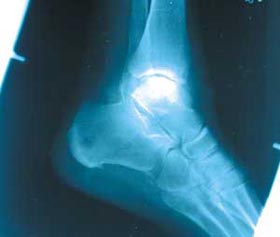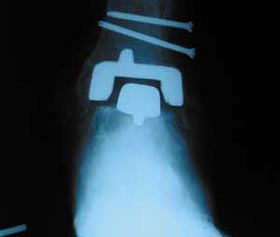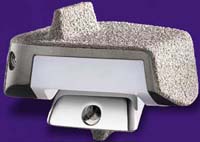Long-term results lend support to ankle arthroplasty
Survivorship at about 90% is nearing that of total hip and knee replacement.
![Frank G. Alvine, MD [photo]](/~/media/images/news/print/orthopedics-today/2003/08_august/frank_alvine_60_90_2097.jpg) --- Frank G. Alvine
developed the Agility total ankle prosthesis and used it to treat nearly 800
patients with arthritic or deformed ankles.
--- Frank G. Alvine
developed the Agility total ankle prosthesis and used it to treat nearly 800
patients with arthritic or deformed ankles.
Outcomes of total ankle arthroplasty now being reported show the procedure has an 11% revision rate at average follow-up of nine years, making it a reasonable alternative to arthrodesis for low-demand ankle arthritis patients.
In light of these results, it is anticipated that later this year insurance reimbursement for total ankle arthroplasty (TAA) will improve, allowing more patients to have the procedure and making way for more designs on the market. Currently some insurance companies either do not reimburse for TAA or have changed their policies to not cover it. Many waited for release of these long-term data.
“This series of nine years should convince anyone,” said Charles L. Saltzman, MD, who is professor of orthopedic surgery and biomedical engineering at the University of Iowa. He has performed approximately 120 total ankle replacements and used DePuy’s semiconstrained Agility ankle prosthesis, the only FDA-approved implant, for 40 of them.
The American Orthopaedic Foot and Ankle Society (AOFAS) recently revised its TAA position statement, moving the procedure into the same category with such operative treatments for symptomatic ankle arthritis as osteotomy and arthrodesis. The AOFAS lists TAA as a viable option for treatment of ankle arthritis.
According to AOFAS President Glenn B. Pfeffer, MD, when ankle arthroplasty was a new technology, the society adopted a cautious position. “But now it’s clear that TAA is a great benefit to appropriate patients,” he said.
Pfeffer and AOFAS board members updated the statement from 2000 after reviewing TAA data from multiple sources. “Even with our appropriately cautious posture, we feel it’s an important surgical option for a patient with ankle arthritis,” he said. He emphasized, however, that ankle fusion is still a reasonable option for many. “The surgeon has a choice and the patient has a choice. The AOFAS position statement supports that choice.”
Promising alternative to arthrodesis
Saltzman and his co-investigators retrospectively studied clinical and radiographic parameters of 132 consecutive TAA patients with eight- to 17-year follow-up. Patients were operated on from 1984 to 1994 by Frank G. Alvine, MD, of Sioux Falls, S.D. Twenty-two received the phase 1 Agility prosthesis and 110 the phase 2 implant available from 1987 through 1997. The phase 2 device had a thicker tibial component and a flat back. Its talar component was made of cobalt chrome instead of titanium.
The validated ankle osteoarthritis scale (0=great; 10=bad) was used to evaluate disability and pain in the patients. Investigators found they were modestly worse overall compared to age-matched controls (2.57 vs. 1.40). Pain subscale scores were even closer: 1.86 for TAA and 1.20 for controls.
More than 90% of the series’ remaining patients, who had 82 implants, were satisfied and would have the procedure again, Saltzman said. “They’re satisfied because the amount of pain is less, and their function is somewhat improved compared to the really debilitating pain they likely had prior to undergoing surgery.”
|
||||
Less morbidity
Agility prosthesis long-term survival rates are approximately 90%, approaching those of total hip and knee replacement. “The phase 2 design was 88% at about five years and now the phase 3, available since 1997, is 89%. We’re certainly proving that the implant does hold up with time, plus the morbidity is less,” said Alvine, who developed the implant and has done nearly 800 cases with it.
“Patients are able to get back into their community a lot quicker than they can with an ankle fusion. Those are some of the reasons why the insurance companies do what they do,” he explained.
But, careful patient selection is critical. In nearly two decades of implanting the Agility prosthesis, Alvine has identified patients who probably should not undergo TAA, including patients with diabetic peripheral neuropathy, extensive talar avascular necrosis and bone loss.
Low-demand patients
TAA is indicated for moderately to severely painful post-traumatic, degenerative and primary or rheumatoid arthritis of the ankle in a relatively low-demand patient with good skin and soft tissue vascularity and good alignment or easily achievable good alignment of the hindfoot, according to Saltzman.
A stable prosthesis is key. In the Agility model it depends to a great extent on early fusion of the syndesmosis, ideally before six months. According to Alvine, lateral support from a good syndesmotic fusion is important, but some long-term patients have done well without it.
In Saltzman’s review, syndesmotic fusion helped stabilize the tibial component. “Radiographic signs of migration and lysis were associated with delayed or nonunion of the syndesmosis,” investigators reported last year. “Once the tibial component became stabilized it did not move in this series of patients,” Saltzman said.
Lysis followed
|
COURTESY OF DEPUY |
Mechanical and expansile lysis were seen on some follow-up radiographs. Approximately half of the patients had evidence of nonproblematic early-onset mechanical lysis. “Three percent of the total group of patients showed progressive expansile lysis at an average of nine years’ follow-up,” he said, which possibly indicated polyethylene or small particulate wear.
In a few patients, talar components subsided in the talar bone and continued to do so for the entire period of the study, often progressing. This occasionally required removal or revision of the component or subtalar fusion, Saltzman said.
Overall, better training has helped. DePuy operates several learning centers to teach physicians to perform TAA, with advanced courses for experienced surgeons. “We’d like to eliminate the learning curve,” Alvine said. But, the ankle joint’s complexity makes the surgery challenging. “It’s not like a hip or knee. Circulation, skin condition and peripheral neuropathy are very real factors.”
Replacing a joint of this nature requires confidence and skill in balancing the foot, Alvine said. “You have to take your time and balance the foot in relationship to the ankle. A malaligned foot just keeps twisting the ankle and then it fails.”
Despite the procedure’s positive aspects, if its more severe complications occur (ie, infection and skin loss) fusion or amputation could be indicated. “If you’re careful with the skin you can avoid many problems, but some of the problems can be long-term disasters,” Alvine said.
“The procedure is here to stay,” Alvine added. “We’ve got it refined now. With the proper patient, the properly trained surgeon and proper use of the implant you can get very good results. I think the insurance companies have to appreciate that.”
Dr. Alvine has a financial interest in the Agility total ankle prosthesis.



